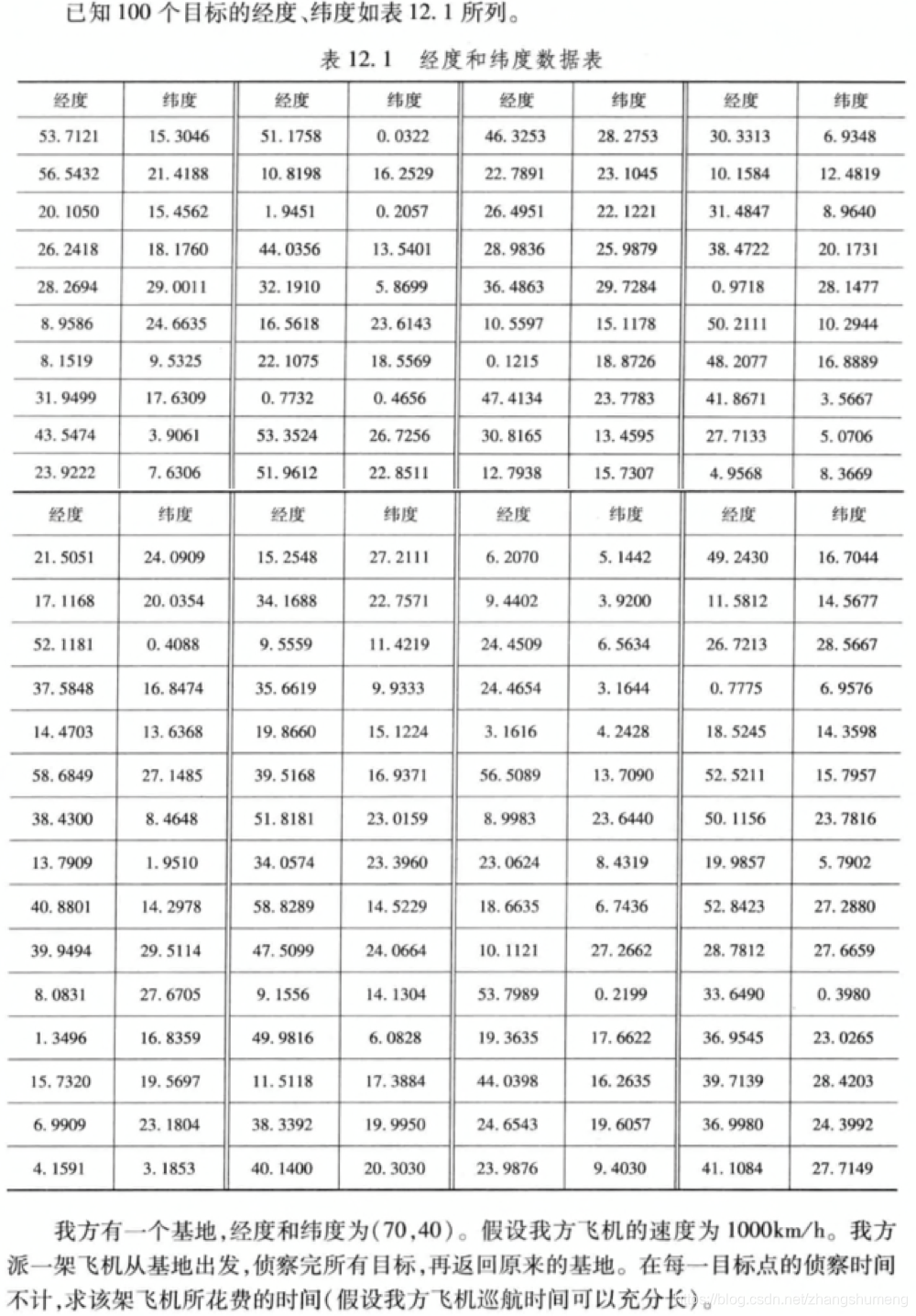
3

经典优化算法——模拟退火
source link: https://blog.csdn.net/zhangshumeng/article/details/112616735
Go to the source link to view the article. You can view the picture content, updated content and better typesetting reading experience. If the link is broken, please click the button below to view the snapshot at that time.
经典优化算法——模拟退火
经典优化算法——模拟退火
各路参考资料上的模拟退火算法都太晦涩难懂了,刚刚简单的学习了一下,希望可以以一种简单的方式说明模拟退火的作用
- 模拟退火算法来源于固体退火原理,是一种基于概率的算法,将固体加温至充分高,再让其徐徐冷却,加温时,固体内部粒子随温升变为无序状,内能增大,而徐徐冷却时粒子渐趋有序,在每个温度都达到平衡态,最后在常温时达到基态,内能减为最小。
简单来说,就是通过设置迭代次数(即退火时温度下降的速度)来达到不断优化结果,计算全局最优解的过程。
下面将从一道题目入手,大致讲解算法:
那么首先,我们需要先计算出任意两位置之间的举例,由于给定值为经纬度,将过建立三维直角坐标系的方式,计算任意两点间的劣弧长度记作两点之间的距离。
即:
化简可得
下面进行算法实现部分
##库的引入
from random import*
import numpy as np
from math import*
from matplotlib import pyplot as pltpoints=np.loadtxt(r'填写csv文件路径',delimiter=',')##进行文件的读写
number_of_points=points.shape[0]
points=np.array(points)
R=1##地球半径,对优化过程无影响故只设为1
def dis(i,j):
temp=np.cos(points[i][0]-points[j][0])*np.cos(points[i][1])*np.cos(points[j][1])+np.sin(points[i][1])*np.sin(points[j][1])
return R*np.arccos(temp)T0=100000000##初始温度
Tf=1##降温停止温度
alpha=0.95##降温比例
wbest=[]
fbest=0
##初始化距离矩阵
distance=np.zeros((number_of_points,number_of_points))
'''
for i in range(number_of_points):
for j in range(number_of_points):
distance[i][j]=dis(i,j)
'''
for i in range(number_of_points):
for j in range(number_of_points):
distance[i][j] = sqrt((points[i][0]-points[j][0])**2+(points[i][1]-points[j][1])**2)
##初始化初解
p=[]
for i in range(number_of_points):
p.append(i)
np.random.shuffle(p)##乱序排列points
print(p)
p=np.array(p)
for i in range(len(p)-1):
fbest+=distance[p[i]][p[i+1]]
fbest+=distance[p[0]][p[-1]]##初始化最佳长度
wbest=p.copy()##初始化最佳路径
f_now=fbest
w_now=wbest.copy()
##开始进行优化
while T0>Tf:
for i in range(10):
x1 = [0 for q in range(number_of_points)]
p1,p2=randint(0,number_of_points-1),randint(0,number_of_points-1)##进行随机取址操作
n = [p1, p2]
n.sort()
p1, p2 = n
##更新路径
if p1>0:
x1[0:p1]=w_now[0:p1]
x1[p1:p2+1]=w_now[p2:p1-1:-1]
x1[p2+1:number_of_points]=w_now[p2+1:number_of_points]
else:
x1[0:p1] = w_now[0:p1]
x1[p1:p2 + 1] = w_now[p2::-1]
x1[p2 + 1:number_of_points] = w_now[p2 + 1:number_of_points]
##更新距离
f=0
for j in range(number_of_points-1):
f+=distance[w_now[j]][w_now[j+1]]
f+=distance[w_now[0]][w_now[-1]]
if f_now>=f:
f_now=f
w_now=x1.copy()
if f_now<f:
t=f_now-fbest
if random() < exp(-t/T0):
f_now = f
w_now = x1.copy()
if f < fbest:
fbest = f
wbest = x1.copy()
T0*=alpha
print(wbest)
print(fbest)
plt.title('SA_TSP')
plt.xlabel('x')
plt.ylabel('y')
plt.scatter(points[...,0],points[...,1])
plt.plot(points[wbest,0],points[wbest,1])
plt.plot([points[wbest[-1],0],points[wbest[0],0]],[points[wbest[-1],1],points[wbest[0],1]],ms = 2)
plt.show()
最后运行就是这样啦(因为数据太多了,所以偷懒只采集的一部分)
模拟退火的本质其实只是一个贪心算法,通过逻辑抽象,模拟固体退火的物理情景,不断的随机取位进行计算,使得答案靠近全局最优
Recommend
About Joyk
Aggregate valuable and interesting links.
Joyk means Joy of geeK